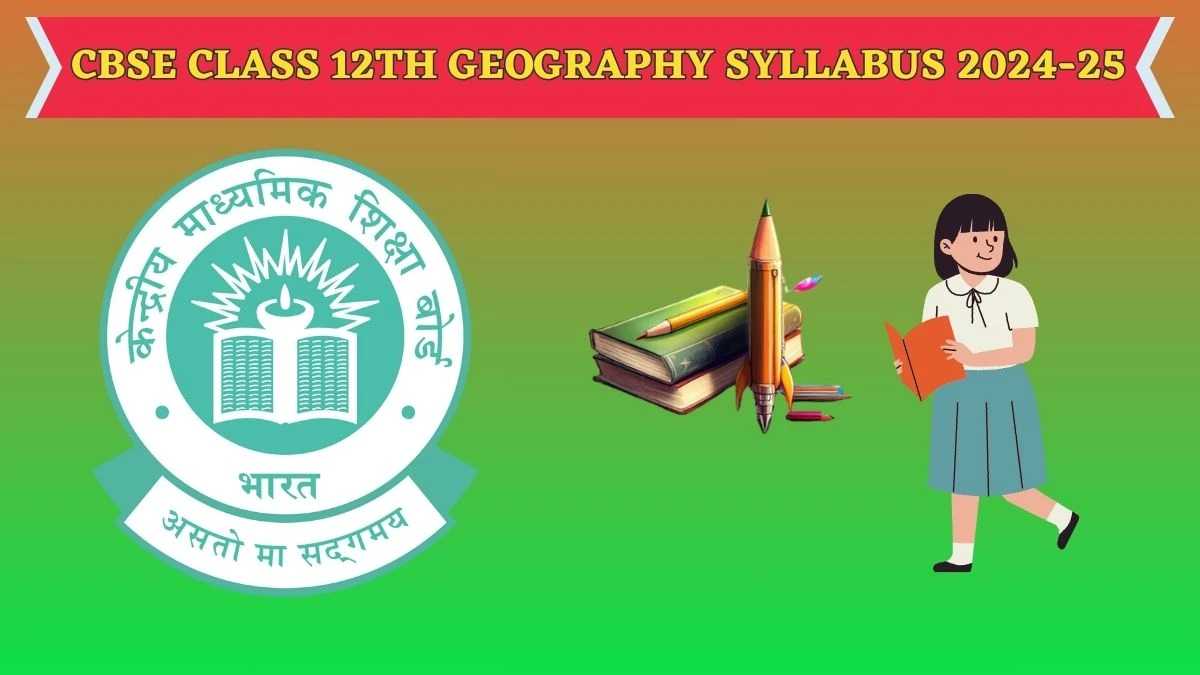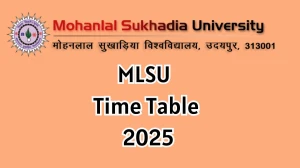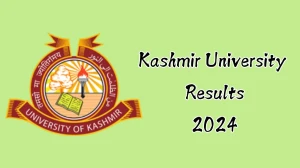- Rojgarlive »
- Education »
- CBSE Class 12th Geography Syllabus 2024-25 cbse.gov.in Check CBSE Class 12th Geography Syllabus
CBSE Class 12th Geography Syllabus 2024-25 cbse.gov.in Check CBSE Class 12th Geography Syllabus
by Sangeetha
Updated Apr 17, 2024

CBSE Class 12th Geography Syllabus 2024-25 @ cbse.gov.in
The Central Board of Secondary Education (CBSE) published the CBSE Class 12 syllabus for the academic year 2024-25 on March 22, 2024. The syllabus for CBSE Class 12 2024 is available for download on the website cbse.gov.in. In this article, students can access PDF files of the CBSE syllabus for all Class 12 subjects. CBSE Class 12 exams will cover the entire syllabus and will be conducted in a single term.
Check - CBSE Class 12th Geography Syllabus 2024-25
CBSE Class 12 Geography Course Content 2024-25
Unlike course structure, course content explains the topics that need to be covered along with its objectives, process and expected outcomes. Check the CBSE Class 12 Geography syllabus or Course content 2024-25 here.
Fundamental of Human Geography
|
Chapter No. and Name |
Specific Learning Objectives |
Suggested Teaching Learning Process |
Learning Outcomes |
|
1 Human Geography |
· To define Human Geography and describe the nature and scope of Human Geography as a discipline. |
· Case Study on determinism and possibilism given in NCERT to be used to explain the concept. · Prepare a concept map of the chapter explaining the following: Definition of Human Geography, nature, scope, schools of thought, branches of Human Geography. |
At the completion of this unit students will be able to: · Define the term human geography. · Elucidate the Interdependence between Nature and Human beings. · State the fields and subfields of Human Geography and its relationship with other branches of Social Sciences. · Differentiate between Environmental Determinism and Possibilism. · Explain Neo-determinism with examples from real life. |
|
2 The World Population- distribution, density and growth |
· To familiarize learners with some basic concepts of Population Geography. · To understand the patterns of population distribution in the world and correlate the factors influencing population distribution. |
· On a world map mark and label ten most populous countries of the world. · Class discussion on how science and technology helped in population growth. · List the reasons for human migration. · On the world map identify the countries of Europe and Asia with negative growth rate of population and African countries with growth rate of population more than three percent. · Students can be asked to find out the density of population of their respective state/ district/ city. · Case Study on Thomas Malthus (optional) · Prepare a glossary. |
At the completion of this unit students will be able to: · Calculate density of population, birth rate and death rate. · Name and define the components responsible for population change. · Understand the stages of population growth in the world using Demographic Transition Theory. · Suggest measures to control population growth. · Define the following terms: Growth of population, Natural growth of population, Positive growth of population, Negative growth of population |
|
3 Human development |
· To understand the concept human development introduced by Dr. Mehbub Ul Haq and Prof. Amartya Sen. |
· The lesson can be introduced by asking students to discuss with their peer group: What is a meaningful life? Discuss: How Beti Bachao and Beti Padhao programme introduced by the Government of India can address the issue of declining sex ratio and make life more meaningful for girls. Enact a play to show how choices get limited due to lack of capability in areas of income, health care and education. Interview a lady vegetable vendor, cobbler and a sweeper in the community and note how their opportunities were limited because of gender, caste and income. |
At the completion of this unit students will be able to: · Differentiate between growth and development · Explain the three basic indicators of human development and measure the level of Human Development. · Describe Human Development Index published by UNDP. · Compare HDI with Human Poverty Index. · Explain the key pillars of human development with examples. · Compare Income approach, Welfare approach, Basic Needs approach and Capability approach to understand the concept Human Development. Categories countries on the basis of their HDI and explain their characteristics. |
|
4 Primary Activities |
· To understand various categories of economic activities. · To describe Primary activities and relate the physical and social factors that affect the type of primary activities practised in different regions of the world. - To explain main features of different types of agricultural system practised in the world. |
· Class discussion: Why are people in coastal areas and plains engaged in fishing and agriculture? · Describe the life of a nomadic herder. (Gaddi and Bakarwal tribe) · Mark and label the following on an outline world map: a.Major areas of subsistence gathering b.Major areas of nomadic herding of the world c.Major areas of commercial livestock rearing d.Major areas of extensive commercial grain faming Major areas of mixed farming of the World |
At the completion of this unit students will be able to: · Define the following terms: Economic activity, Primary activities, Red Collar Worker, Pastoral Nomadism · Explain food gathering as an economic activity. · Distinguish between pastoral nomadism and commercial livestock rearing. Differentiate between primitive subsistence and intensive subsistence farming. Describe the characteristic features of plantation agriculture as a type of commercial farming. Analyse why is there low yield per acre but high yield per person in areas of extensive grain cultivation. Compare and contrast the farming practices in the developed urban areas of the world. Analyse how the model of Kolkhoz introduced in the erstwhile USSR boost agricultural production. Examine the reasons for success of cooperative farming in the European countries. Differentiate between open cast mining and shaft mining. Discuss how mining can have impact on humans and environment. |
|
5 Secondary Activities |
· To develop understanding of secondary activities with emphasis on manufacturing industries. · To give an overview of manufacturing processes, types, its significance and recent changes. |
· The students can be asked to prepare a list of factory-made goods they use in their daily life and categorize them as biodegradable and non- biodegradable. · List out ten global brands, their logos and products. · The students can be taken out for a visit to local industry and asked to prepare a report on their observations regarding raw material used, finished product, production process, labour inputs, environmental impact and social responsibility. · The students can be asked to prepare a sketch, poster, poem or write-up about the environmental conditions surrounding an industry. |
At the completion of this unit students will be able to: · Explain key concepts such as, large-scale manufacturing, high technology industry, organizational set up, foot-loose industries, Agri business etc. · Identify and explain the factors affecting the location of an industry. · Differentiate between different types of industries on the basis of size, raw material, ownership and output. · Differentiate between cottage industry and small-scale industry. · Explain the importance of high- tech industries and reason for them being attracted to the peripheral areas of major metropolitan cities. · Compare large scale industry and modern high-tech industry with examples. · Understand and analyses the interrelationship between industrial development and standard of living. |
|
6 Tertiary and Quaternary Activities |
· To understand different types of tertiary activity and its importance in the economy. |
· Make a list of economic activities under different categories. · Make a list of departmental stores and chain stores that you visit regularly. · Class discussion on: How convenient and beneficial the fast-growing service sector in the world. |
At the completion of this unit students will be able to: · Compare and contrast traditional and modern economic activities. · Students correlate tertiary activities and their role in the economic development of a country. · Describe different types of tertiary activities. · Discuss different types of trading centres found in rural and urban areas and role played by them in local economy. · Describe quinary activities and its role in advanced economies. · Discuss how tertiary, quaternary and quinary activities have replaced jobs in primary and secondary sectors. · Define the following terms: BPO, Outsourcing, KPO, Departmental Store, ChainStore, Wholesale trading |
|
7 Transport and Communication |
· To acquire knowledge about various modes of transport in different continents. · To compare and synthesize the information about major transport routes around the globe. · To understand the development of communication networks and their impact on the modern world. |
· Students can be asked to do a survey of their class about the means of transport being used by students to reach school. Prepare a Bar diagram with the help of the data collected. · Analyze the connection between physical landscape and development of various modes of transport. · Mark and label the terminal stations of Trans-Siberian Railway, Trans Canadian Railway and Trans Australia Railway on an outline world map. · Draw a sketch map of Suez Canal, Panama Canal, St Lawrence Sea ways and Rhine waterways, and mark them on an outline map of the world. · On an outline map of the world mark and label the following major airports of each continent: a. Asia: Tokyo, Beijing, Mumbai, Jeddah, Aden b. Africa: Johannesburg & Nairobi c. Europe: Moscow, London, Paris, Berlin and Rome d.North America: Chicago, New Orleans, Mexico City e.South America: BuenosAires, Santiago f.Australia: Darwin and Wellington |
At the completion of this unit students will be able to: · Compare and contrast various modes of transport. · Explain the relationship of transport and communication networks to economic development of a region. · Describe the major highways and major rail networks of different continents. · Discuss the location and economic significance of Trans- Siberian Railway, Trans Canadian Railway, The Union and Pacific Railway and Trans Australian Railway. · Describe the location and the economic importance of the major sea routes of the world. · Discuss how Suez Canal and Panama Canal serve as major gateways of commerce for both the eastern and the western world. · Discuss how the modern communication systems have made the concept of global village a reality. |
|
8 International Trade |
· Familiarize the students with the basic concepts and principles of international trade. · To understand the basis of international trade, Balance of trade and types of international trade. · Gain knowledge about the concept of Dumping. · To outline the historical perspective of globalization and role of WTO, its functions and its implications on the world trade. · Examine the importance of sea ports as gateways of international trade |
· Discuss: How International trade was carried out in the past vis-a-vis present times. · Study the data given on table 9.1 and compare world import and export to calculate balance of trade and analyse its implication. · Read the case study on dumping and discuss how dumping is becoming a serious concern among trading nations. · Prepare a concept map of the chapter. · Mark and label the headquarter of WTO on an outline world map. · Mark and label the following major sea ports of the world: a. Europe: North Cape, London, Hamburg North America: Vancouver, San Francisco, New Orleans b. South America: Rio De Janeiro, Colon, Valparaiso Africa: Suez and Cape Town c.Asia: Yokohama, Shanghai, Hong Kong, Aden, Karachi, Kolkata Australia: Perth, Sydney, Melbourne |
At the completion of this unit students will be able to: · Define international trade and describe how it impacts various countries. · Describe the basis of International Trade. · Discuss types of and aspects international trade. · Explain the term Dumping, Trade liberalisation and Globalisation. · Discuss the impact of WTO on current global trade. · Evaluate how international trade can be detrimental to some nations. · Analyse how seaports act as chief gateways of International trade. |
CBSE Class 10 Geography Practical Work 2024-25
|
Chapter No. and Name |
Learning Objectives |
Suggested Teaching Learning Process |
Learning Outcomes |
|
1 Data its source and compilation |
· To understand the importance of data and its uses in Geography |
· Collect Primary and Secondary Sources of data from different sources and exhibit in practical file |
· Define data. · Differentiate between primary and secondary sources of data. · List several sources of data. |
|
2 Data Processing |
· To calculate Measures of Central tendency · To Compare Mean, Median and Mode |
· Calculate Mean, Median and Mode using direct and indirect method |
· Calculate the mean rainfall of your city. · List ten Himalayan peaks with their heights and calculate the median height using the data. |
|
3 Representation of data |
· To represent data graphically using different techniques |
· Construction of Line Graph · Bar Graph · Poly Graph Line and Bar Graph Multiple Bar Diagram Compound Bar Diagram Pie Diagram Thematic Maps Dot Map Choropleth Map Isopleth Map |
· Construct a line graph to represent the growth rate of Population in India 1901-2011. · Construct a polygraph to compare the growth of sex ratio in different states. · Construct a line and bar graph to represent the average monthly rainfall and temperature of Delhi. · Construct a multiple bar diagram to represent decadal literacy rate, male literacy and female literacy. · Draw a pie diagram to show India’s export to major regions of the world 2010-2011. Construct a dot map to show India’s Population 2011. Construct a choropleth map to show state wise variation in population density. |
|
4 Spatial Information Technology |
· To understand the need to capture data from different sources and integrate them using a computer that is supported by geo-processing tools. · To learn basic principles of the Spatial Information Technology and its extension to the Spatial Information System, which is more commonly known as Geographical Information System. |
. |
· Explain Spatial Information Technology or GIS. · Describe the advantages of GIS over manual methods. · Components of GIS · Spatial Data formats · Raster data format · Vector data format · Spatial Analysis · Overlay and Buffer Analysis. |
CBSE Class 12th Geography Syllabus 2024-25 - FAQs
The CBSE Class 12 Geography syllabus for the academic year 2024-25 covers various topics and concepts related to the subject.
The CBSE Class 12 Geography syllabus for the academic year 2024-25 can be found on the official CBSE website or by visiting cbse.gov.in.




